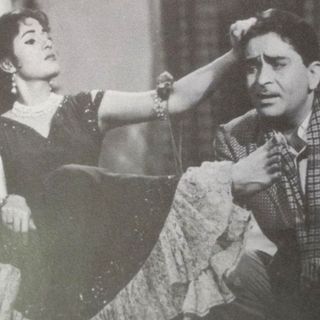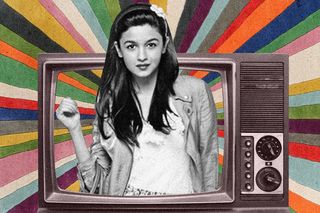
Can We Move On? From the Mean Girl Trope As A Depiction of Hyper‑Competitiveness Between Women
Beautiful, well-off, casually cruel, and now, thankfully, irrelevant.

In Can We Move On, we revisit old tropes and question whether they have any remaining cultural relevance.
For young girls in the ’90s, terror was pink, poufy, and spouted the rudest burns. The Mean Girl ruled schools full of confused, hormonal teenagers with a dictator’s iron fist and the aimless cruelty of a teenage girl who had it all.
The Mean Girl trope gave young people — especially young girls — in the 90s and the early 00s an understandable super-villain. While Godzilla took down entire cities by brute force, Regina George from Mean Girls broke people’s spirit via psychological warfare. Her campy propensity to be cutting was both hilarious and outrageous — we loved her, secretly wanted to be her, but always wanted to take her down.
For the young girls who watched these teen movies, the moral messaging around Mean Girls was about why unkindness and judgmental behavior were not okay. But, as the 90s kids grew up, the Mean Girl began to symbolize more bleak ideas of social hierarchy. The Mean Girl’s dominance over other girls, the subterfuge, and psychological evisceration she performed to uphold her dominance, became a hyper-ostentatious parody of womanhood itself — to exist as a woman was to constantly compare against and compete with other women. The Mean Girl trope had us all believe that the dark side to womanhood is catty, conniving competitiveness. The problem is, the trope assumes womanhood as the reason for catty, conniving behavior, and never explores anything more.
Related on The Swaddle:
Narcissism Is a Diagnosable Illness, Not Just a Cultural Supervillain Trope
In the real world, women did indeed deploy aggression, meanness and awful behavior to cut other women down. In her personal essay about women’s competitions and aggression, Kelly Valen writes, “We women swim in shark-infested waters of our own design.” But, the necessary difference to observe between real ‘mean’ women and the Mean Girl trope, is that the former are not prone to aimless cruelty or ‘cattiness’ simply by virtue of being women. There are multiple forces involving race, gender, identity, class, and various other intersections that inform the meanness — which is often lost in translation from real to reel.
For example, young women are aggressive to other women and slut-shame them more often due to class barriers rather than gendered bullying. Women can be aggressive to each other at the workplace, but ‘bitchy female bosses’ at work are quite rare, no matter how much the term ‘queen bee‘ is thrown around. More often than not, it’s a larger-than-life trope plastered upon a women trying to navigate tokenism in sexist workplaces, women who are not as kind as their gender roles need them to be, and women who enjoy competition rather than real life Miranda Priestly from The Devil Wears Prada.
Related on The Swaddle:
It’s Okay: To Envy Other Women
Both on screen and in real life, women find themselves bound to tropes dictated by stereotypes pushed by people with no clue about what it’s like to live as a young girl or a woman. Heathers, though a cult classic social satire, depicts a coterie of Mean Girls who are mean without any explanation. In comparison, Mean Girls, another classic social satire, allows its super-villain nuance. Regina has extremely acquiescent parents, leading to her sense of superiority and uncontrolled aggression. The former, scripted by a man, does not bother to provide context and relies on stereotypes, while the latter, scripted by a woman, still relies on stereotypes but does take the time to explain the context behind them.
Waves of feminists have attempted to discern and work towards why women compete with each other, and how they can work together instead. Their work ranges from Shine Theory, which posits women’s ability to befriend and learn from other women, to upholding kindness as a deeply underrated feminist way of life. This work is both possible and shows gradual results because they consider women’s hyper-aggressiveness and competition as a reaction to societal forces rather than innate. This shift has yielded results — Mean Girls on screen now come with nuance, background stories, and motivations, because the audience will simply not accept ‘women are catty.’ Negative, preppy and competitive female characters now come with back-stories (Cheryl Blossom in Riverdale), are friendless for their competitive nature (Sharpay Evans in High School Musical), and are often redeemed as worthy of love (Rosalie Hale, Twilight series).
Mean people will continue to exist, and so will unhealthy, hyper-aggressive competition. But one can, with cautious optimism, say that depicting women as catty and hateful with no explanation or backstory is bound to get blowback from young girls and women who know that they are multifaceted. The victory of this progress means the Mean Girl is dated now and will become further obsolete, living on in our pop culture imaginations as fuel for hilarious burns and barbs that mean nothing mean at all.
Aditi Murti is a culture writer at The Swaddle. Previously, she worked as a freelance journalist focused on gender and cities. Find her on social media @aditimurti.
Related


Tell Me More: Talking Poetry and Protest With Shantanu Anand, Co‑Founder of Airplane Poetry Movement
